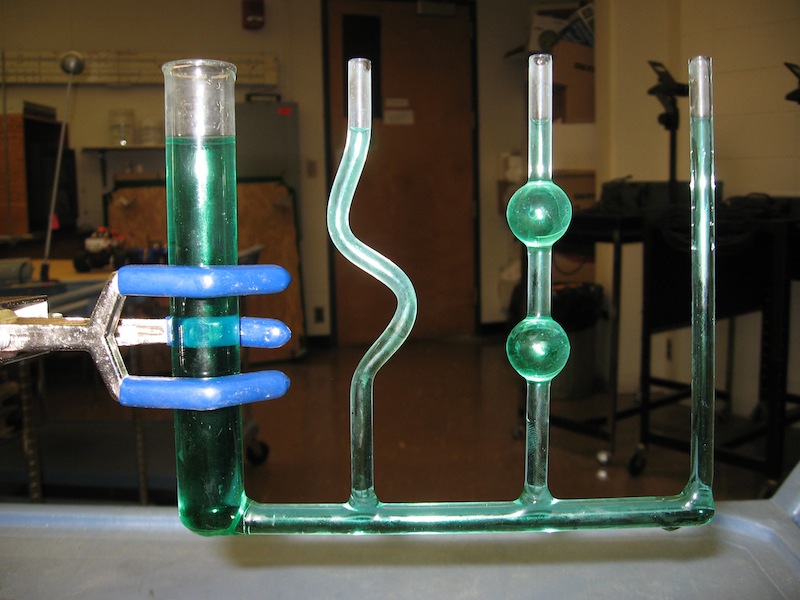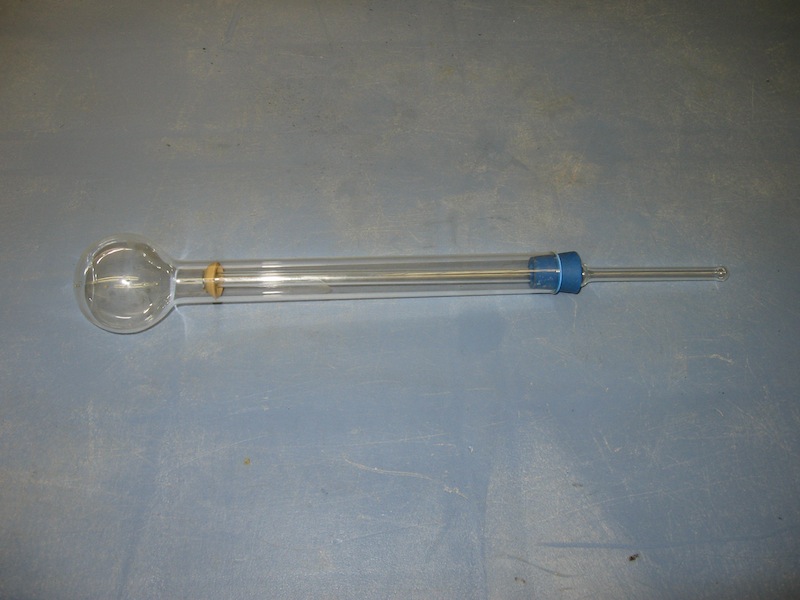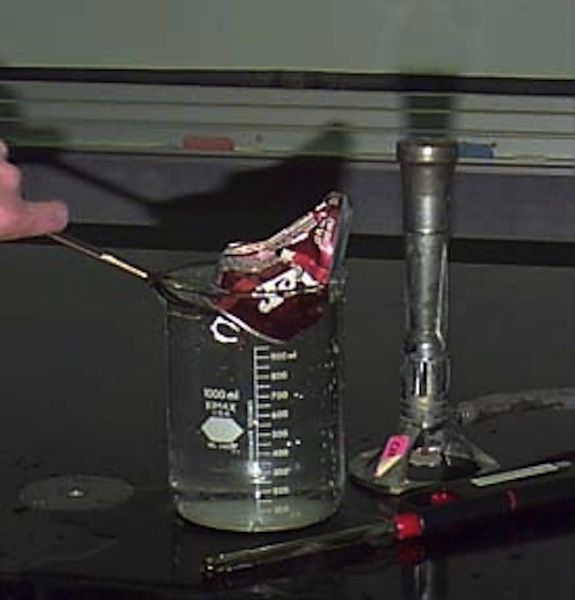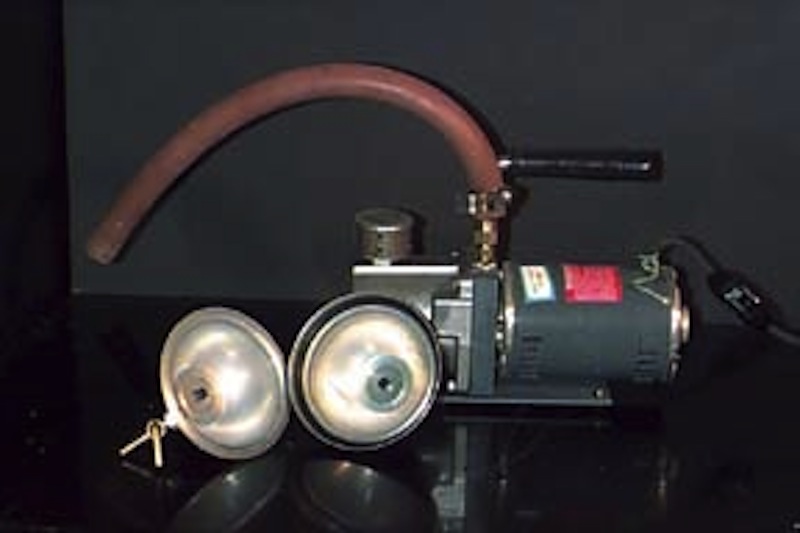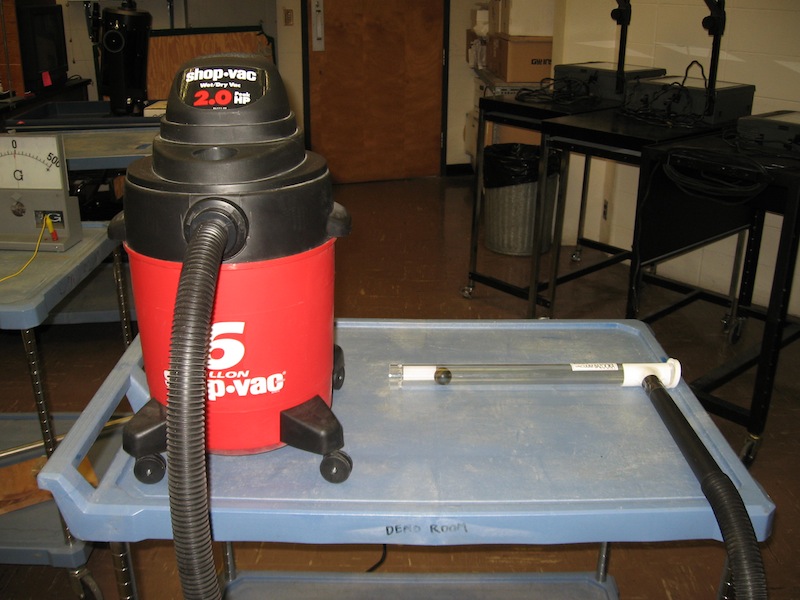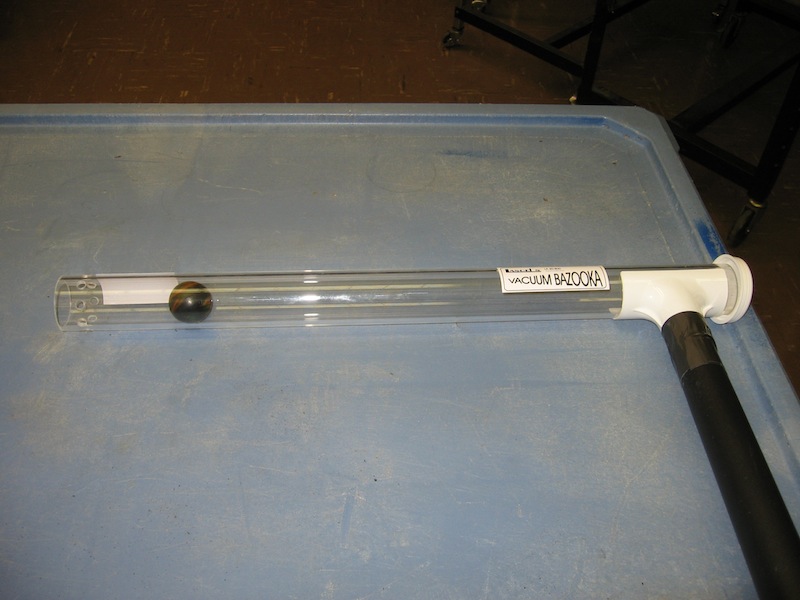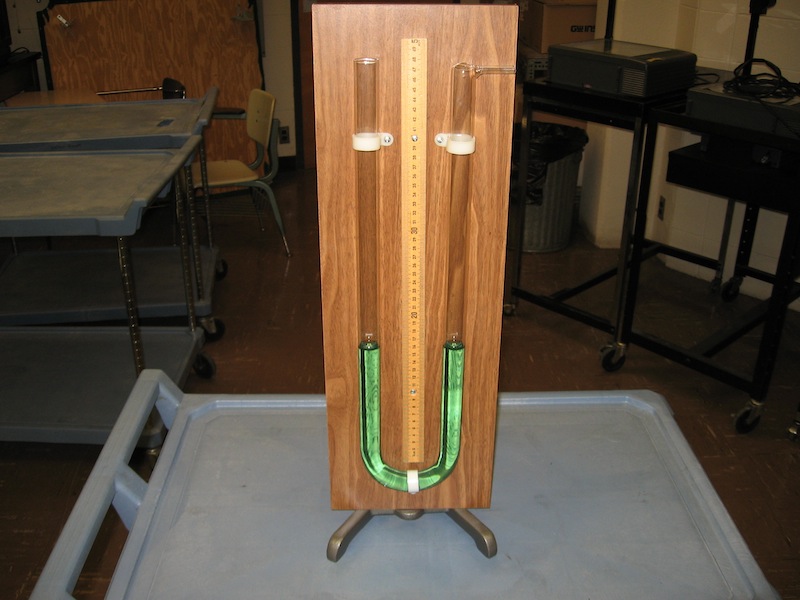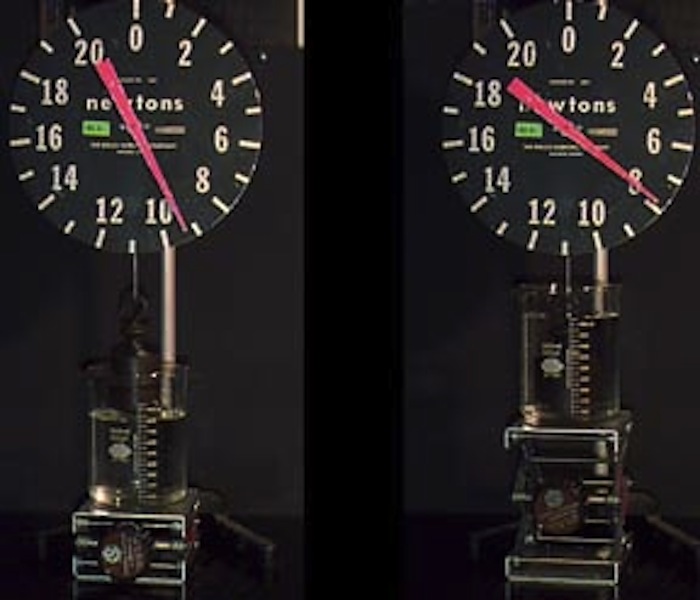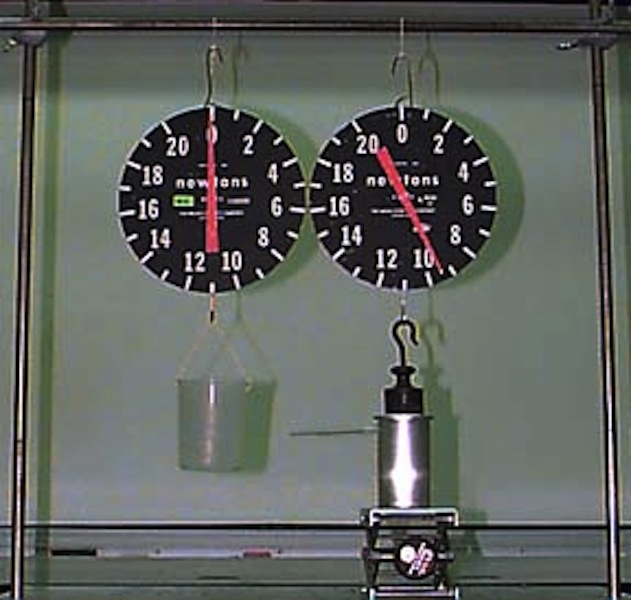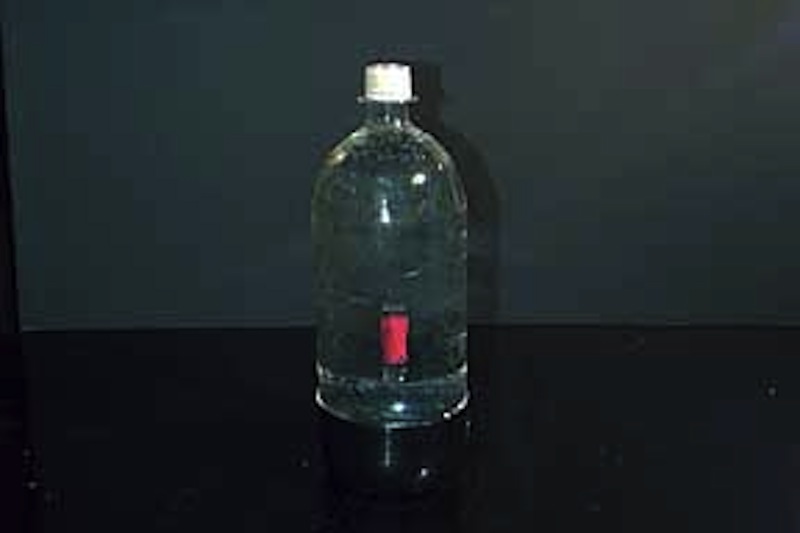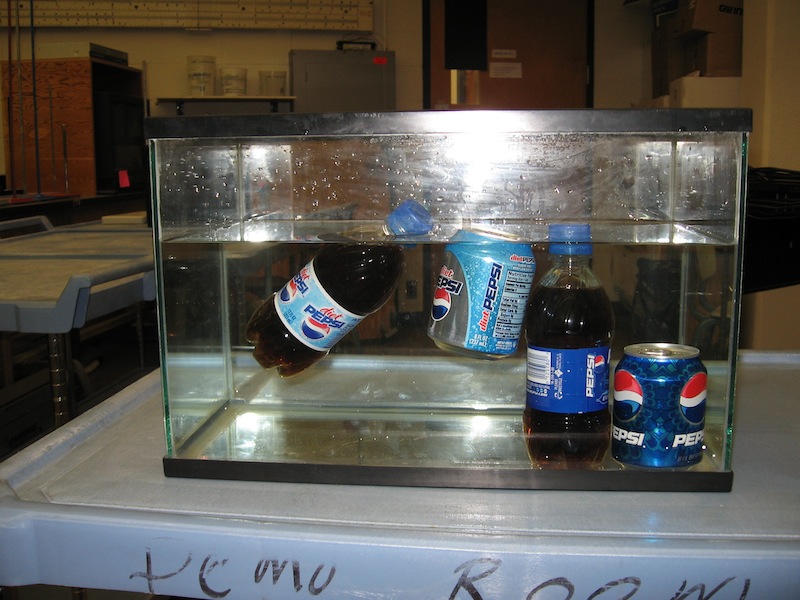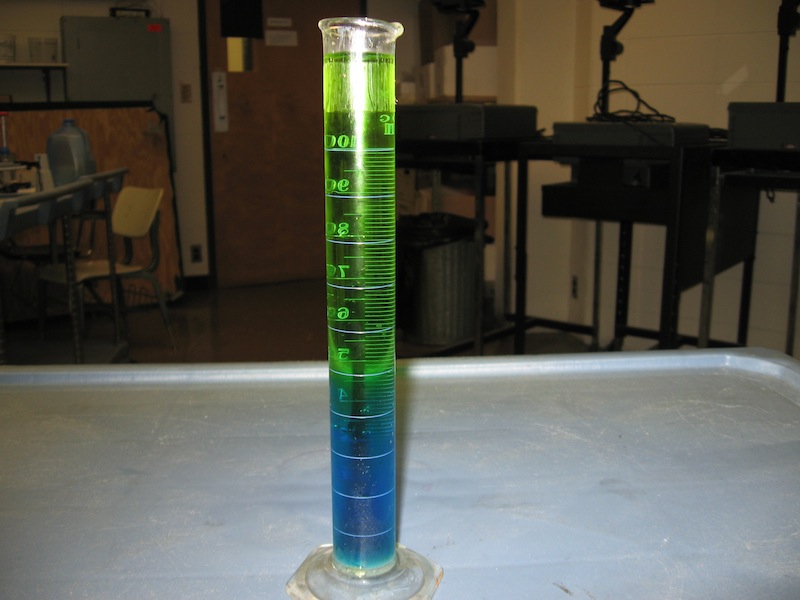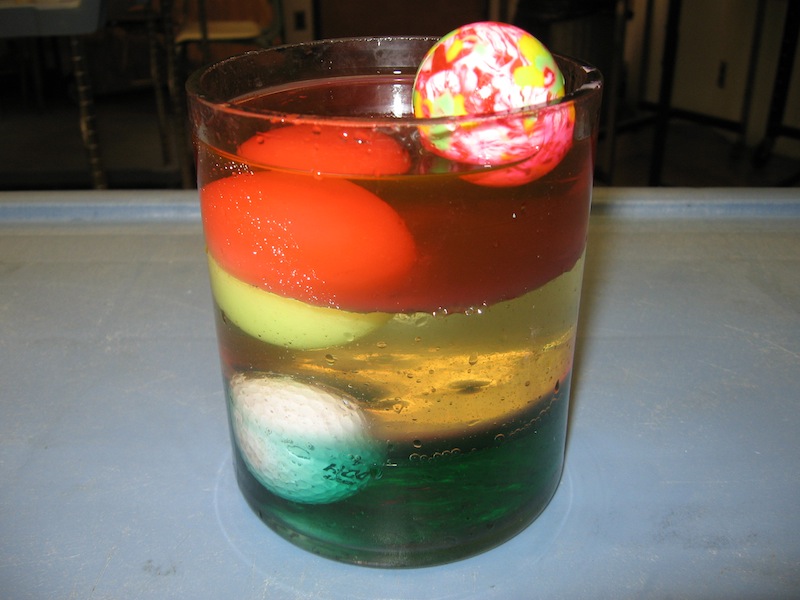STATICS OF FLUIDS
2B20.40 PASCALS' TUBES2520.50 PASCAL'S PLUNGER
2B30.10 CRUSH THE CAN
2B30.30 MAGDEBURG HEMISPHERES
2B30.70 VACUUM BAZOOKA
2B35.30 U TUBE MANOMETER
2B40.10 WEIGH SUBMERGED BLOCK
2B40.20 ARCHIMEDES PRINCIPLE
2B40.30 CARTESIAN DIVER
2B40.54 CLASSIC VS DIET DRINK
2B40.59 HOT & COLD LAYERS (See also 4A10.20 Galileo Thermometer)
2B40.71 THREE LAYER FLUID
2B60.85 HYDRAULIC LIFT
|
2B20.40 Pascal's Tubes Containers of various shapes are connected to a common water reservoir. The height of the water will be the same. Setup Requirements: Minimal
Equations: P = density x g x height regardless of shape
Safety Issues: Broken glass if you are careless. Spilling water on electronic devices. |
|
2B20.50 Pascal's Plunger Pascal's Principle device. Push on plunger. Pressure will be transmitted throughout fluid causing it to squirt out holes.This is what will happen to car brake system if a leak occurs.
Setup Requirements: Minimal. Fill with water when ready to use.
Equations: Pressure is transmitted throughout fluid
Safety Issues: Device is made of glass. Wet students or equipment. |
|
2B30.10 Crush The Can Demonstrate pressure of air. Boil water in a can. The steam displaces some of the air. Tape shut. As the vapor pressure is reduced by cooling, the can collapses.
Setup Requirements: Assembled as needed. Put a small amount of water in can. Usually a hotplate is used instead of gas burner. This will take a few minutes to become red hot and boil water.
Equations: None
Safety Issues: Red hot electric hotplate or gas burner. Hot water. Gloves available |
|
2B30.30 Magdeburg Hemispheres Another demonstration of the strength of air pressure. Evacuate Magdeburg hemispheres. Try to separate them. Relate to difficulty of opening car door if underwater. Ten meters of water equals 1 atm additional pressure.
Setup Requirements: Vacuum pump needed. A screw driver and clamp is needed to hold hose on hemisphere. Press hemispheres togther while pumping. Close valve and disconnect hose. Turn off pump. Try pulling hemispheres apart.
Equations: Air pressure equals 14.7 psi. P = F/A
Safety Issues: None |
|
2B30.70 Vacuum Bazooka A ball placed in the left end is moved through due to the low pressure area created by the vacuum cleaner and comes out the other end either knocking the cap off or tearing through thin paper. Use as attention getting device when talking about 2 dimensional motion. The device can also be used when talking about the force exterted by a pressure. That is why it has been put in this PIRA category.
|
|
2B35.30 U Tube Manometer Use this water filled version of a U Tube manometer to show how difference in height of the fluid in the two sides can be used to measure pressure. Attach a hose to the connection and blow or use PASCO hand pump to create a partial vacuum. Setup Requirements: Minimal. Food coloring added to make water visible.. Equations: Pressure = Density x g x height difference. Safety Issues: breaking glass tube, spilling liquid |
|
2B40.10 Apparent Weight Loss of Submerged Mass Lower a weight suspended from a spring scale into water and note the new weight .
Setup Requirements: Assembled as needed. Ask ahead of time.
Equations: Buoyant Force = density x volume x g
Safety Issues: Spilling water on desk. Keep away from electronic devices. |
|
2B40.20 Archimede's Principle Suspend a weight from a spring scale, lower the weight into water and collect the overflow into the pail. The apparent weight decreases as the object is lowered into the water.You may want to weigh the overflow to show its weight equals apparent weight loss of object in water.
Setup Requirements: Ask ahead of time. Requires some time to assemble on special cart.
Equations: Weight "loss" = dVg=weight of displaced water
Safety Issues: Spilling water on desk. Keep away from electronic devoices. |
|
2B40.30 Cartesian Diver Squeeze a stoppered bottle to make the diver sink. The increase in pressure causes the volume of diver to decrease resulting in reduction of buoyant force. Setup Requirements: Off the Shelf. Several types available
Equations: F(B) proportional to V.
Safety Issues: None |
|
2B40.54 Classic vs Diet Drink What determines whether an object sinks or floats? Put a can of Classic Coke or Pepsi and a can of Diet Coke or Pepsi in one of our fishtanks. The classic drink can will sink. The diet drink can will float. There is about 2 gm difference due to using fructose vs Nutra Sweet. Setup Requirements: Ask ahead of time or bring your own drinks. Vending machine with cans was removed. Need time to fill fish tank. There is such a small difference in mass that can to can variations, temperature of can and temperature of water can make a difference.
Equations: Whether it sinks or floats depends on the ratio of the density of the object to the density of the fluid.
Safety Issues: Tank is heavy when filled. |
|
2B40.59 Hot & Cold Layers Demonstrate floating depends on density. Slowly add hot water until full. The top part will turn green where the water mixes. The bottom part stays blue. Setup Requirements: Some time needed to heat up water on hotplate in class. Cold water can be prepared before class. Color hot water with yellow food coloring. Color cold water with blue food coloring. Fill cylinder about 2/3 full with cold water.
Equations: Whether it sinks or floats depends on the ratio of the density of the top layer to the density of the bottom layer. Density depends on temperature.
Safety Issues: Hotplate, hot water |
|
2B40.71 Three Layer Fluid Demonstration has three liquids with different densities and objects of different densities floating at different levels. Setup Requirements: Prepared as needed. Advance notice needed.
Equations: Whether it sinks or floats depends on the ratio of the density of the object or layer to the density of the fluid .
Safety Issues: None |
|
2B60.85 Hydraulic Lift Pascal's Principle device. Pressure is transmitted through fluid. Small force applied to small area piston produces large force on large area piston. Put car on large piston and show how much mass needed to move car up. Then try again with car on small piston.
Setup Requirements: Minimal. Use yellow car. Use 500 gm and 2kg masses.
Equations: P = F / A
Safety Issues: Avoid dropping weights. |

